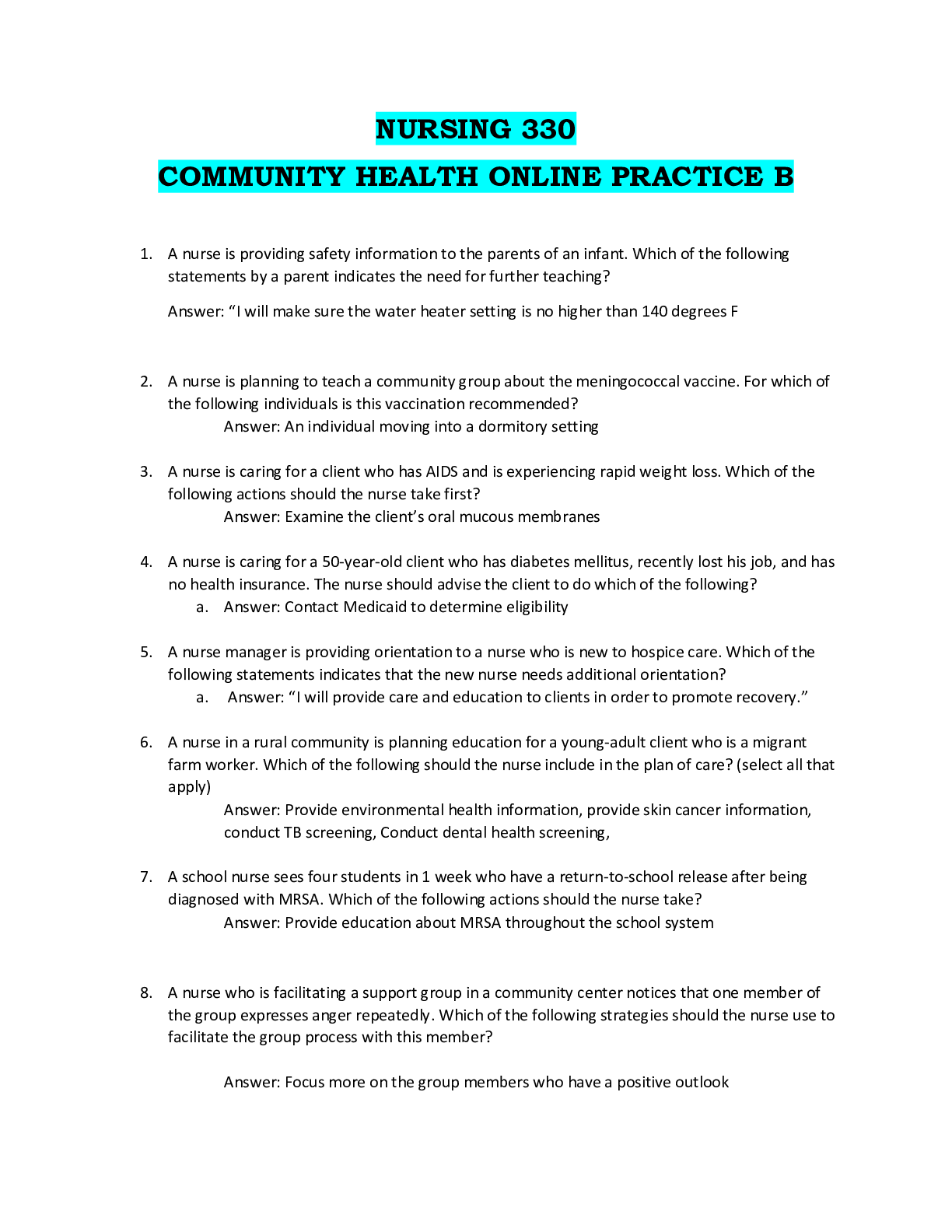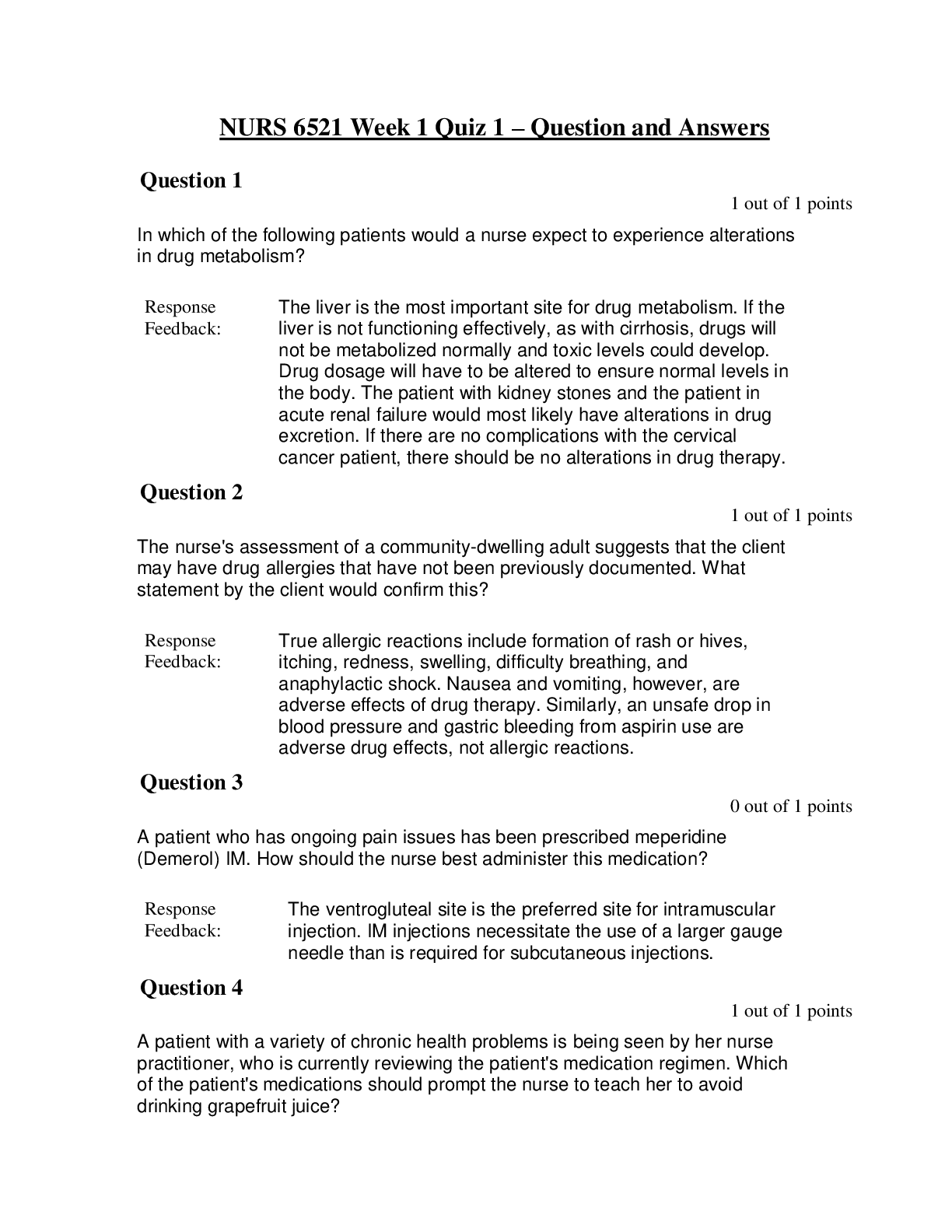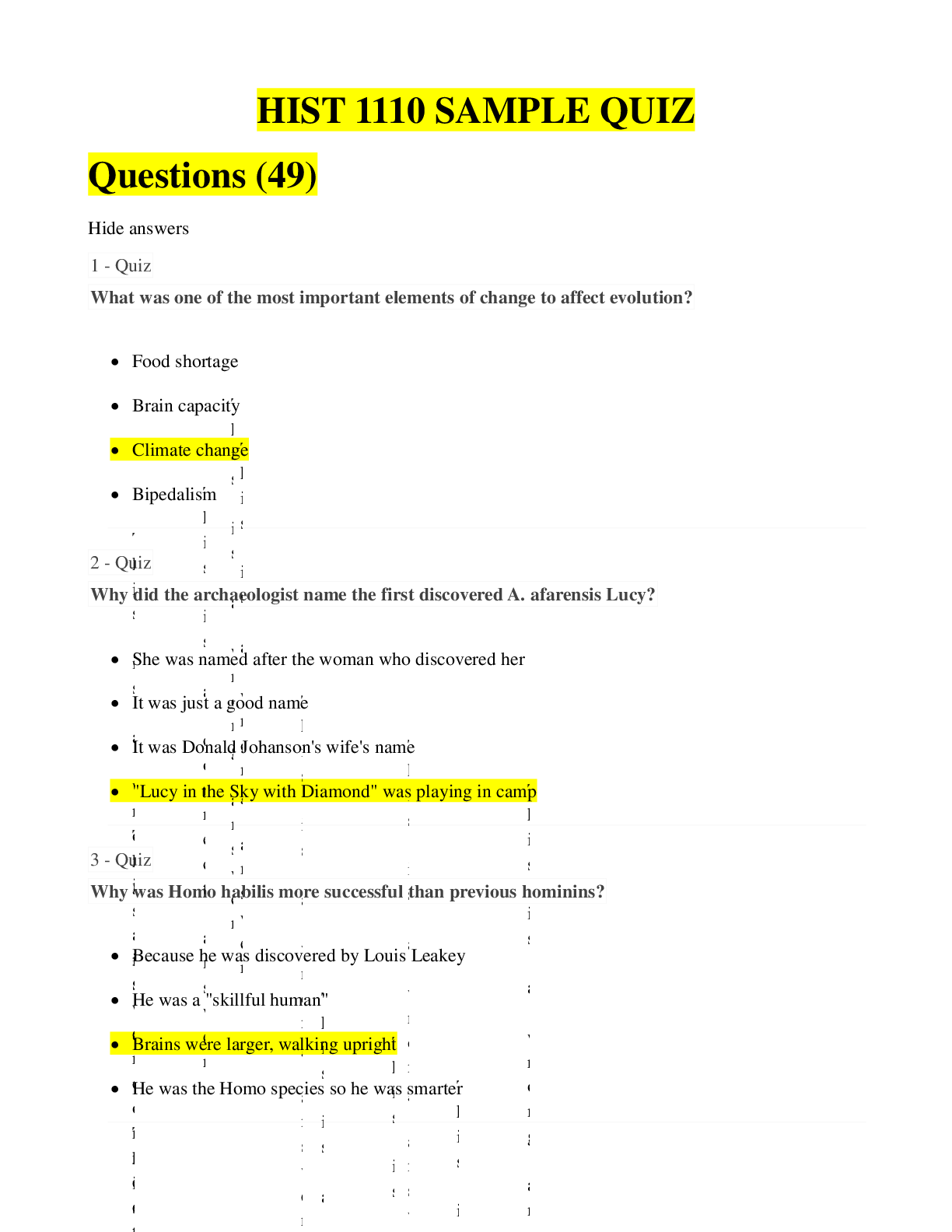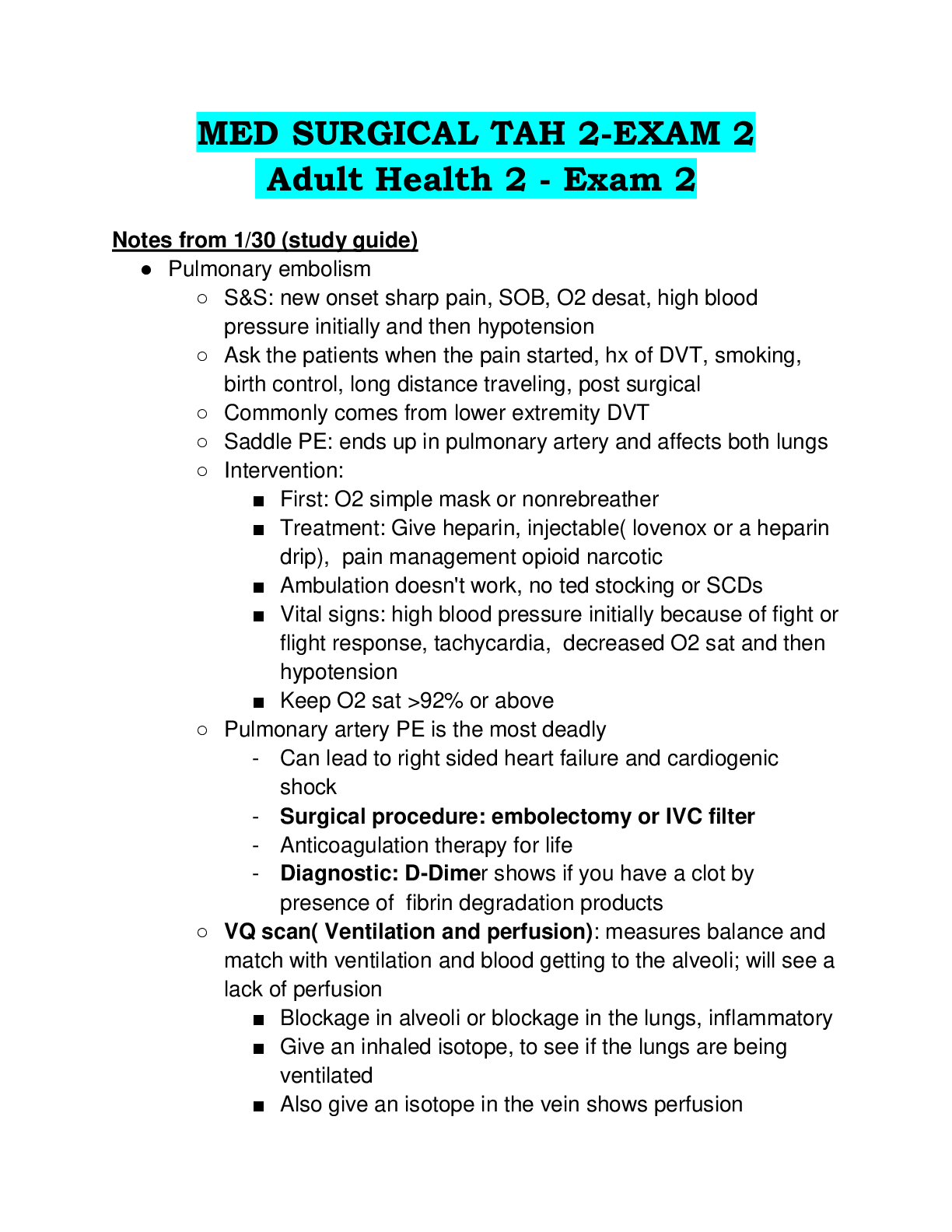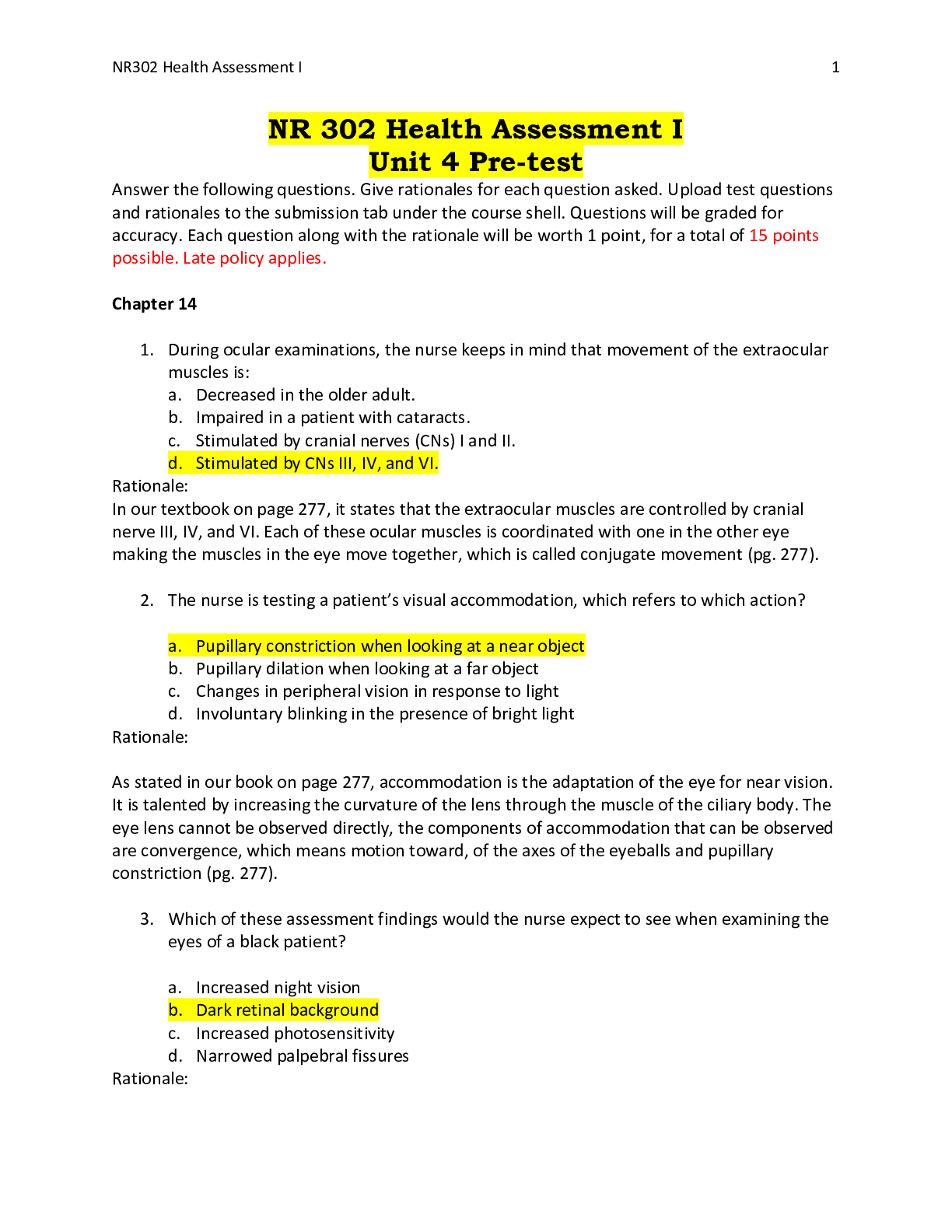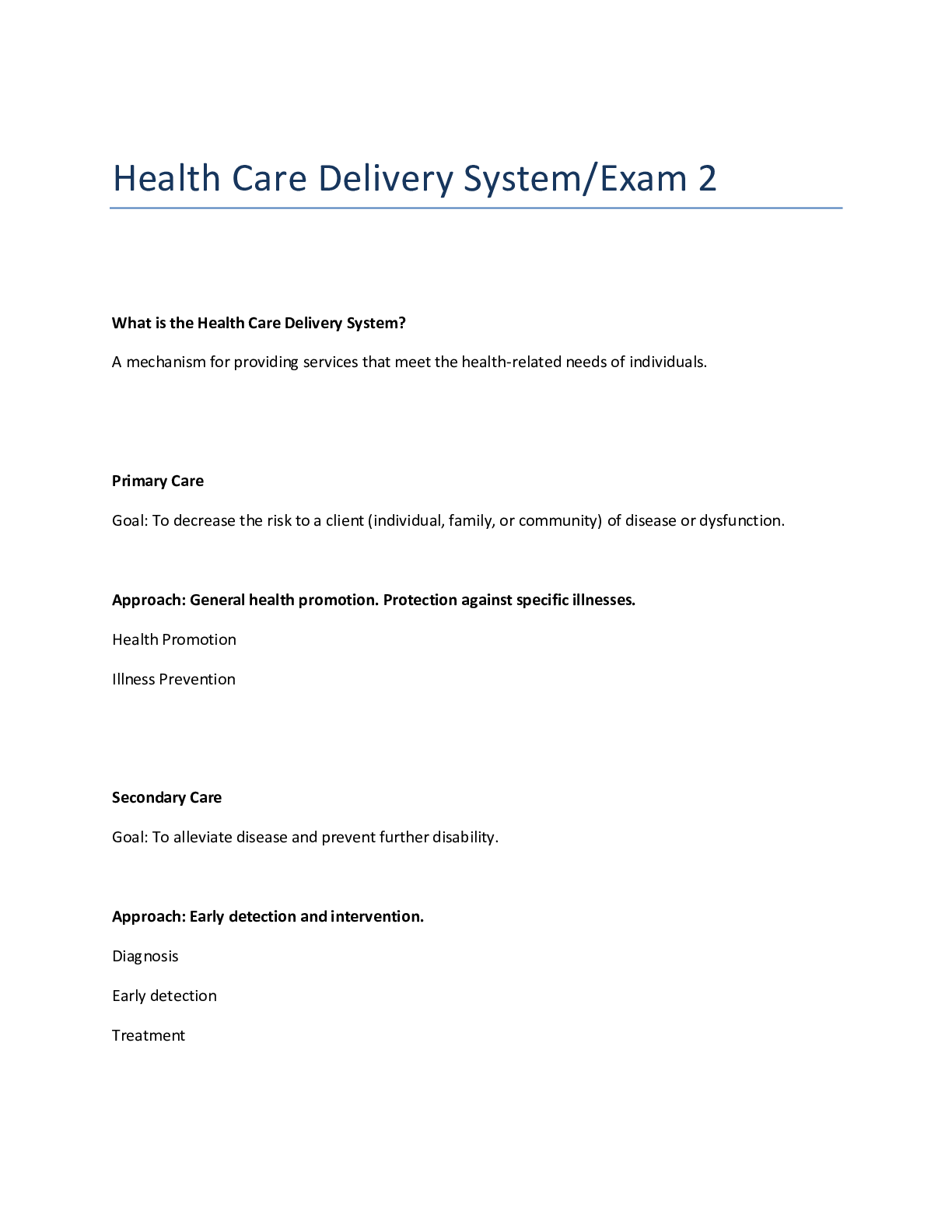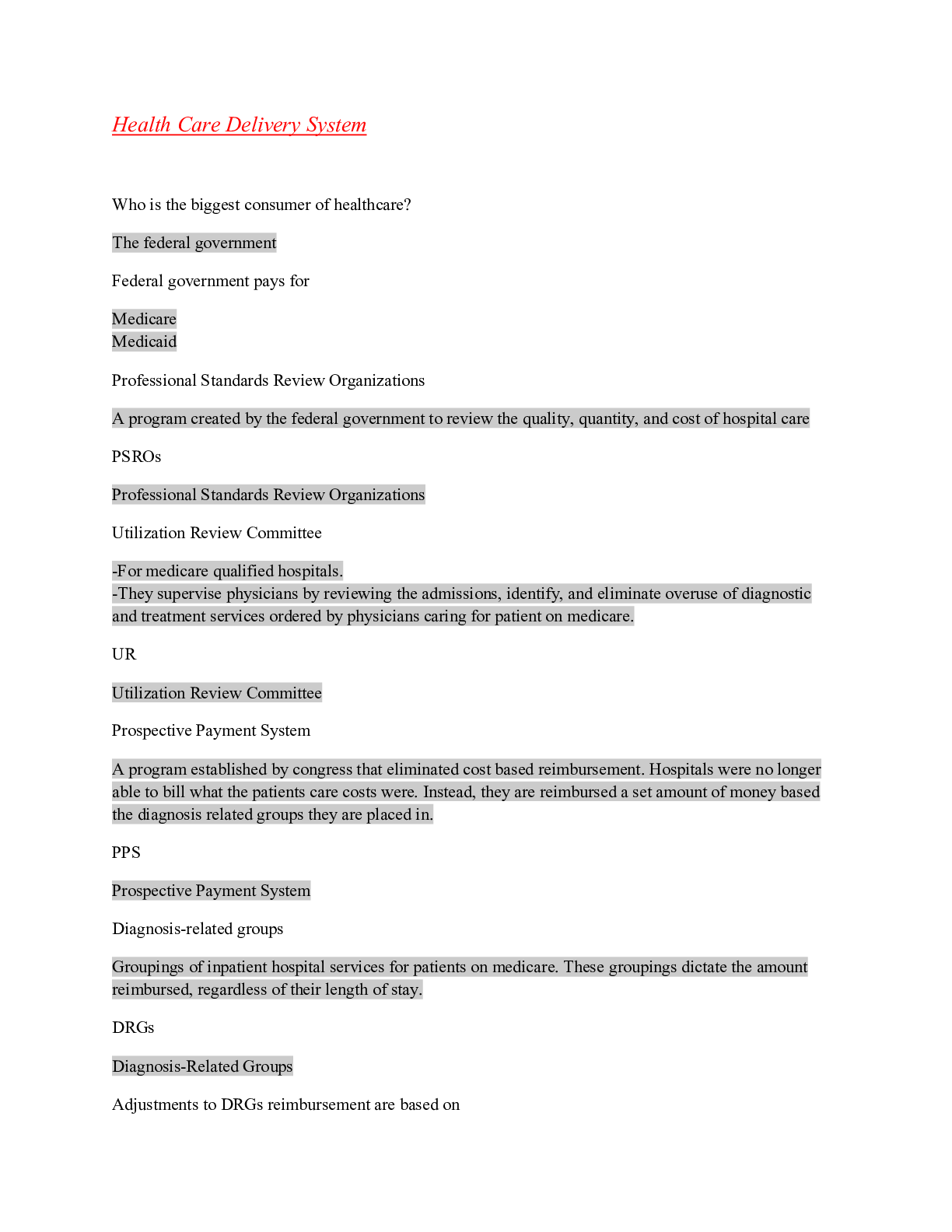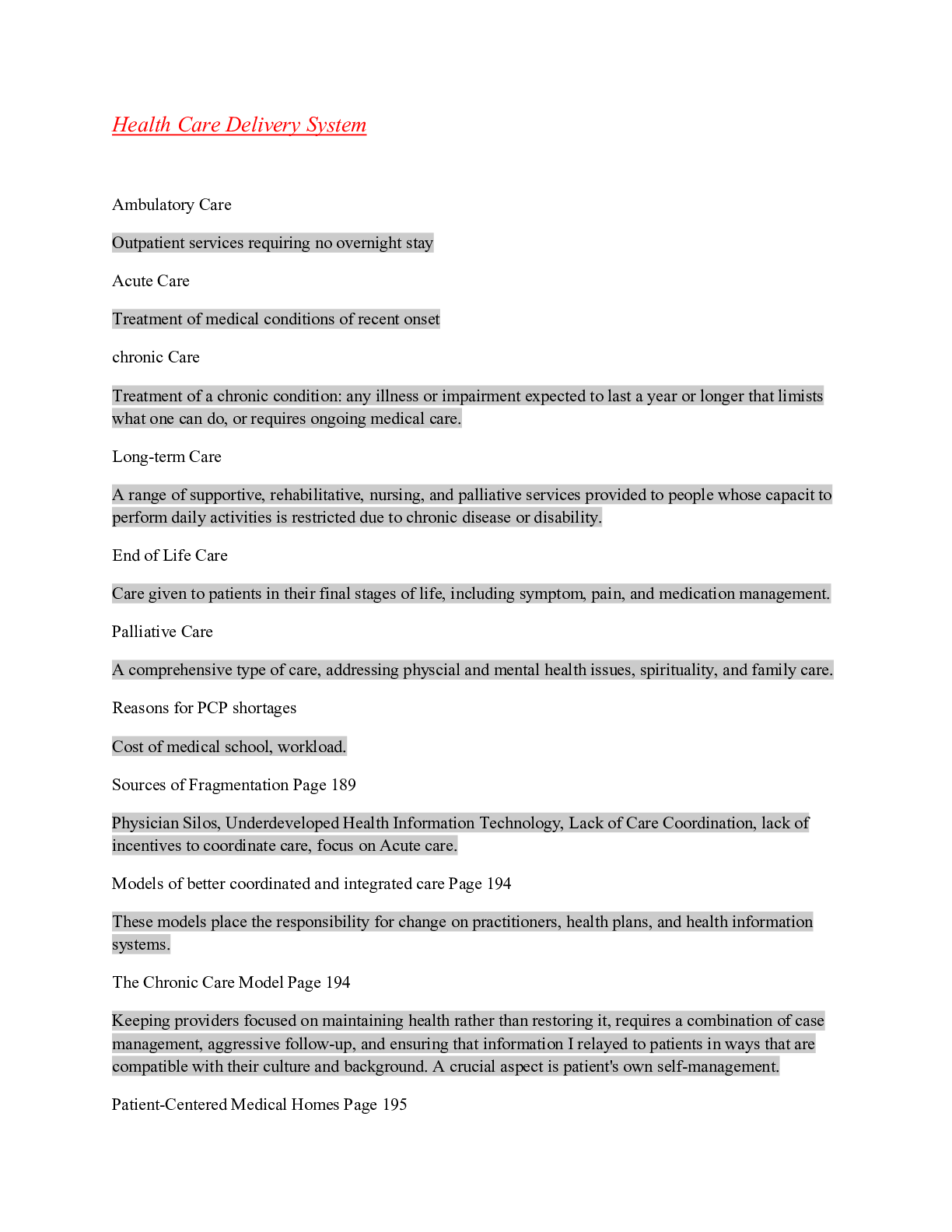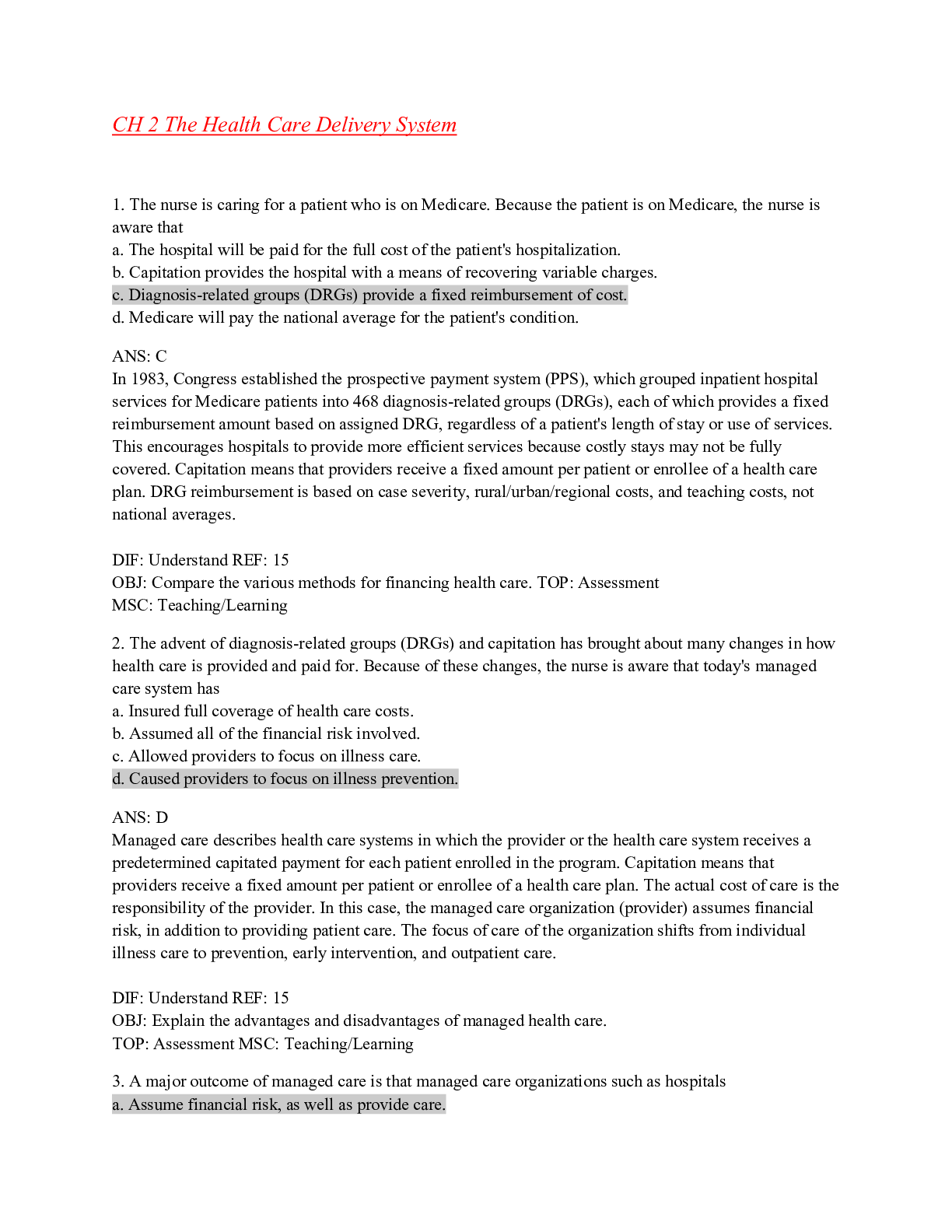Health Care > EXAM > Health Care Delivery System Exam Guide Questions Continued. Latest (All)
Health Care Delivery System Exam Guide Questions Continued. Latest
Document Content and Description Below
Health Care Delivery System Exam Guide Comprises of all those involved in healthcare including: institutional settings, agencies, policies, payment plans, providers, and clients and families Healt... h Care Delivery System The levels of health care include: Primary Secondary Tertiary This type of health care helps with health promotion and illness prevention; it can be directed at an individual or a community Primary Prevention Some examples of providing primary prevention include: adequate nutrition; weight control; exercise; stress management; immunizations; identifying measures to prevent disease; identifying risk factors for disease; This type of health care helps with diagnosis and treatment; it is traditionally the largest segment service in the health care system Secondary Prevention This type of health care helps with rehabilitation and health restoration and palliative care; also helps with the process of restoring to optimum level of wellness or to highest level of health that one is capable of Tertiary Prevention Some goals for Rights and Health Care include: improving quality of health care; making the system responsive to client's needs; protecting client's autonomy and independence; In 1973, American Hospital Association (AHA) published: A Patient's Bill of Rights Types and Services recognized in the healthcare setting include: different institutions providing various types of care; changes being seen in response to changes in our healthcare system; trend toward community-based care; nurses involved in care in all settings Community-based care is: provided in many different settings and focuses on health promotion and health restoration across the lifespan; provides more needs and services outside hospital Home Setting Nursing Care includes: assessments, meds, teaching, physical care, family support, collaborate with other healthcare services Home Setting care is influenced by: prospective payment systems or DRG's; elders not requiring institutionalization; those who desire to stay in home; more clients choosing to die at home Home Setting care is provided through: community health departments; visiting nurses' associations; hospital-based care managers; home-health agencies Also known as diagnostic related groups which assist with earlier discharges and influenced through prospective payment system DRG's Hospitals and Crisis Intervention Centers are examples of: Acute Care Settings Employ more nurses than any other settings Hospitals Help with diagnosis and treatment; provided for those too ill to be cared for at home; focused on the acute-care needs of clients Crisis Intervention Centers Physician Offices are an example of: Primary Care Settings Physician Offices assist with: physicals, minor illnesses, minor surgeries, OB/Gyn care, well-child care, counseling and referrals Ambulatory Care Centers are: located for convenience; may be "walk-in"; may provide variety of services such as urgent/emergency care; outpatient surgery; general healthcare Some examples of Specialized Care Centers are: day-care centers; mental health centers; rural health centers; schools; industrial; shelters; rehab centers Some Long-Term Care Settings are: extended care facilities; life care centers; rehab; psychiatric Special services available to terminally ill patients; may include inpatient/home care; committed to maintaining quality of life and dignity of dying Hospice Some measures in order to maintain the quality of life and dignity of dying of those in hospice include: open communication; symptom management; comfort measures; support of family Volunteer agencies, religious agencies, government agencies, and public health are some examples of: Other health care centers Some providers of health care include: nurses; physicians; physician assistants; physical therapist; respiratory therapist; occupational therapist; speech therapist; dietician; pharmacist; social worker; chaplain; dentists; optometrists; nurse practitioners; psychologists; lab personnel; diagnostic services; administrative; community workers; Some trends in healthcare include: healthcare services; organization; access; healthcare coverage; costs; Medicare/Medicaid; distribution of resources; planned change These are goals to provide cost-effective, quality care that focuses on improved quality outcomes; planned care to ensure standards are met and costs minimized; national trend toward this framework of care; choise will be between organizations NOT health care providers Managed Care Systems HMO's are an example of: Managed Care Systems Coordinates client's healthcare to maximize outcomes and contain costs; focus to enhance continuity of care; provides protocols and timetables and follows client from diagnosis to home Case management A delivery model that brings all services and care providers to the clients; involves cross-training and collaboration; clients will perceive improved care and service Patient Focuses Care Client-centered method where one nurse is assigned to comprehensive care of a group during an 8-12 hour shift and provides consistent contact with client during the shift Case Method Focuses on jobs to be completed, centralized authority, and efficiency Functional Method Some disadvantages of the Functional Method include: task oriented, fragmented care, "nonquantifiable" aspects of care may be overlooked Individualized care led by a professional nurse (RN) and consists of RN's, LPN's and Nurse's Aids (UAP); they coordinate care during a shift with delegation of appropriate tasks Team Nursing One nurse responsible for total care for a number of clients 24/7; assesses patients and develops plans of care and evaluates effectiveness Primary Nursing The manager of the client's care who plans, coordinates, and communicates with client the RN Some examples of financing healthcare are: insurance companies, PPO's (preferred providers), Preferred Provider Arrangement (PPA's), HMO's (Health Maintenance Organization) Majority of these are private, profit-making; manage to provide a profit as well as services to policy holders; based on shared risk; limits on coverage; have influence and power by limiting healthcare decisions between provider and client; involved in standards of care Insurance Companies Insurance companies that have negotiated a contract with a group of healthcare providers to provide services at a lower fee in return for prompt payment and guaranteed volume of clients PPO's or Preferred Providers Healthcare providers outside the group, client would agree to pay additional out-of-pocket expenses; arrangement made with a single provider instead of a group PPA's or Preferred Provider Arrangement Fees are flat rate per month; Primary health providers are often employed and receive a set salary; may/may not have choice of providers; incentive for preventive medicine, emphasizes client wellness HMO's or Health Management Organization Some examples of what HMO's help cover: routine, preventive care, care for illness, hospitalizations, sometimes Rx, outpatient care, Two major government financing providers are: Medicaid and Medicare Insurance program for persons over 65, healthcare costs have been larger than anticipated, hx abuse and fraud Medicare Federally funded program for persons of LES (elderly women and children) Medicaid Two regulatory agencies are: joint commissions; DNV Healthcare (Det Norske Veritas) Non-governmental agency that approves or accredits hospitals; profound impact on how these agencies operate Joint Commission Works with healthcare providers to improve healthcare delivery through risk management DNV Healthcare Some problems in healthcare delivery are: cost of healthcare; cost of new technology; construction of new facilities; DRG's; population of aging; salaries and diversity of providers; supplies and drugs; lack of competition Originated in 1983 when Medicare converted to a "prospective payment plan"; hospital receives predetermined, fixed rate; determined by diagnosis or procedure regardless of actual cost; pays only the amount pre-assigned to the diagnosis DRG's Some nursing implications considering healthcare include: trends in approaches to healthcare may actually benefit nurse; nurses can provide cost-effective care for clients in a variety of settings; studies show a need for more advanced practice nurses Some things to know for the admission process: the unit to receive patient usually notified by admission office; room assignment made; room prepared; admission assessment; physician notified of admission; nurse responsible to assess the needs of the client and the family; documentation; wait for physician's physical and admission orders Some things to know for the transfer process: goal to make transfers as smooth as possible; clients have to adjust to new settings, roommates, routines, care providers; all can cause stress and anxiety; nurse responsible for meeting the comfort, safety and knowledge needs of the client and family; order from a physician; notify appropriate people; care of personal property; give report Some things to know about the discharge process: begin to plan for discharge on day 1; usually coordinated by nursing; requires careful planning, teaching and documentation; involve the patient and family; discharge assessment; discharge instructions by RN only; accompany to door What is AMA (against medical advice)? legally free to do so; a form must be signed releasing physicians and facility from legal responsibility; witnessed; part of permanent record The affordable care act is when: young adults can remain on parental insurance until age 26; lowers the cost of meds for people on medicare; removes lifetime limits on coverage; goal is to reduce the number of uninsured Americans; fines given for those without coverage Service Excellence is achieved when: patients perception of care is quality; core measures are taken; HCAHPS; rounding for outcomes; bedside report is done; key words are used at key times Provides safe consistent communication between caregivers; reduces break in communication during handoff report; Joint Commission recommends this as best practice SBAR SBAR stands for: Situation Background Assessment Recommendation Nutrition counseling for young adults with a strong family history of high cholesterol is a good example of what? Primary Prevention Activity Public health agencies are funded by governments to: investigate and provide health programs In most cases, clients must have a primary care provider in order to receive health insurance benefits. If a client is in need of a primary care provider, it is most appropriate for the nurse to recommend a: family practice physician The most significant method for reducing the ongoing increase in the cost of health care in the US includes controlling: competition among drug and medical equipment manufacturers A client seeking to control health care costs for both preventive and illness care. Although no system guarantees exact out-of-pocket expenditures, the most prepaid and predictable client contribution would be seen with: a health maintenance organization (HMO) The ANA's Health System Regorm Agenda included: Case management should be focused on clients with enduring health care needs The Pew Commission competences for future practitioners included the need for providers to become skilled in the: use of technology What is a characteristic of nursing care provided in community-based health? Clients are individuals in groups according to their geographic commonalities. When performing collaborative health care, the nurse must implement: rely on the expertise of other healthcare team members [Show More]
Last updated: 1 year ago
Preview 1 out of 7 pages
Instant download

Buy this document to get the full access instantly
Instant Download Access after purchase
Add to cartInstant download
Reviews( 0 )
Document information
Connected school, study & course
About the document
Uploaded On
Nov 21, 2022
Number of pages
7
Written in
Additional information
This document has been written for:
Uploaded
Nov 21, 2022
Downloads
0
Views
33


